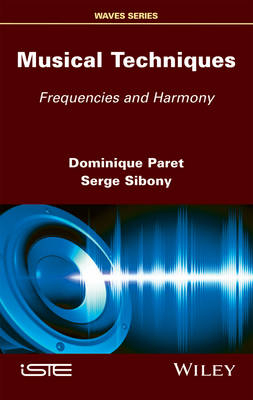
Musical Techniques
ISTE Ltd and John Wiley & Sons Inc (Verlag)
978-1-78630-058-4 (ISBN)
- Titel z.Zt. nicht lieferbar
- Versandkostenfrei innerhalb Deutschlands
- Auch auf Rechnung
- Verfügbarkeit in der Filiale vor Ort prüfen
- Artikel merken
Dominique PARET, CEO/CTO at dp-Consulting. Serge SIBONY, Professor of Complex Systems Engineering.
Preface xiii
Introduction xv
Part 1. Laying the Foundations 1
Introduction to Part 1 3
Chapter 1. Sounds, Creation and Generation of Notes 5
1.1. Physical and physiological notions of a sound 5
1.1.1. Auditory apparatus 5
1.1.2. Physical concepts of a sound 7
1.1.3. Further information on acoustics and acoustic physiology 8
1.1.4. Idea of minimum audible gap/interval between two frequencies 16
1.1.5. Why have we told this whole story, then? 22
Chapter 2. Generation of Notes 23
2.1. Concept of octave 23
2.1.1. Choice of inner division of an octave 24
2.2. Modes of generation/creation/construction of notes 25
2.3. Physical/natural generation of notes 26
2.3.1. Harmonics 26
2.3.2. Fractional harmonics 26
2.3.3. Initial conclusions 29
2.3.4. Order of appearance and initial naming of the notes 29
2.3.5. A few important additional remarks 32
2.4. Generation of perfect fifth notes 33
2.4.1. Generation with ascending fifths 33
2.4.2. Generation with descending fifths 37
2.4.3. Conclusions on fifth-based constructions of notes 39
2.5. Important remarks on “physical”/”fifths” generation 40
2.6. Generation of tempered notes 40
2.6.1. Notion of the ear’s logarithmic sensitivity 41
2.6.2. Examples of electronic generation of tempered notes 43
2.6.3. Relative gaps between tempered and electronic notes 43
2.7. In summary and in conclusion on generation of notes 46
2.8. Comparison of gaps between all the notes thus created 49
2.8.1. Note on pitch-perfect hearing… or is it? 53
Chapter 3. Recreation: Frequencies, Sounds and Timbres 55
3.1. Differences between a pure frequency and the timbre of an instrument 55
3.2. Timbre of an instrument, harmonics and harmony 58
3.2.1. Relations between timbres and spectra 60
3.3. Recomposition of a signal from sine waves 63
3.3.1. Subtractive synthesis 63
3.3.2. Additive synthesis 63
3.3.3. Recreation: harmonic drawbars 64
Chapter 4. Intervals 69
4.1. Gap/space/distance/interval between two notes 69
4.2. Measuring the intervals 70
4.2.1. The savart 70
4.2.2. The cent 71
4.3. Intervals between notes 73
4.3.1. Second interval: major tone and minor tone 74
4.3.2. Major third and minor third interval 75
4.4. Overview of the main intervals encountered 75
4.5. Quality of an interval 76
4.5.1. Instrumentation 76
4.5.2. Tempo 76
4.5.3. Dynamics of amplitudes 76
4.5.4. Register 76
4.6. Reversal of an interval 77
4.7. Commas…ss 77
4.7.1. Pythagorean comma 78
4.7.2. Syntonic comma 79
4.7.3. A few remarks about commas 80
4.7.4. Enharmonic comma 80
4.7.5. Other theoretical commas and a few additional elements 80
4.7.6. Final remarks 82
4.7.7. In summary, commas and C° 83
Chapter 5. Harshness, Consonance and Dissonance 85
5.1. Consonance and dissonance 85
5.1.1. Consonant interval 85
5.1.2. Dissonant interval 86
5.2. Harshness of intervals 86
5.3. Consonance and dissonance, tension and resolution of an interval 87
5.3.1. Consonance of an interval 87
5.3.2. Dissonance of an interval 89
5.3.3. Savarts, ΔF, consonance, pleasing values or beating of frequencies 90
Part 2. Scales and Modes 93
Introduction to Part 2 95
Chapter 6. Scales 97
6.1. Introduction to the construction of scales 97
6.2. Natural or physical scale 98
6.2.1. Harmonics 98
6.3. Pythagorean or physiological diatonic. scale 100
6.3.1. Principle 100
6.3.2. The why and wherefore of the 7-note scale 101
6.3.3. Names of the notes in the Pythagorean scale 104
6.3.4. The series “tone-tone-semi/ tone-tone-tone-tone-semi/tone”? 105
6.3.5. A few comments 106
6.3.6. Uses of the Pythagorean scale, and cases where it cannot be used 107
6.4. Major diatonic scale 108
6.4.1. Intervals present in a major scale 108
6.5. The other major scales 109
6.6. Scales and chromatic scales 109
6.6.1. Chromatic scale 110
6.6.2. Chromatic scales 110
6.7. Tempered scale 114
6.7.1. Principle of the tempered scale 114
6.7.2. Comparisons between physical, Pythagorean and tempered scales 115
6.8. Other scales 117
6.9. Pentatonic scale 117
6.9.1. A little history, which will prove important later on 117
6.9.2. Theory 118
6.9.3. Reality 120
6.9.4. Relations between major and minor pentatonic scales 123
6.9.5. Pentatonic scale and system 124
6.10. “Blues” scale 125
6.11. Altered scale and jazz scale 126
6.12 “Tone-tone” (whole-tone) scale 127
6.13. Diminished scale or “semitone/tone” scale 128
6.14. In summary 128
6.15. Technical problems of scales 129
6.15.1. Scale and transposition 130
6.15.2. Alterations 132
Chapter 7. Scales, Degrees and Modes 135
7.1. Scales and degrees 135
7.2. Degree of a note in the scale 136
7.3. Interesting functions/roles of a few degrees of the scale 136
7.4. Modes 137
7.4.1. The numerous modes of a major scale 138
7.4.2. The original minor modes and their derivatives 142
7.4.3. A few normal modes 143
Part 3. Introduction to the Concept of Harmony: Chords 145
Introduction to Part 3 147
Chapter 8. Harmony 149
8.1. Relations between frequencies 149
8.2. How are we to define the concept of harmony? 150
Chapter 9. Chords 151
9.1. The different notations 151
9.1.1. Convention of notations for notes 151
9.2. Chords 152
9.3. Diatonic chords 153
9.3.1. Diatonic chords with 3 notes: “triads” 154
9.3.2. 4-note diatonic chords known as “seventh” chords” 155
9.4. “Fourth-based” chords 157
9.4.1. Convention of notations of the chords 157
9.5. Chord notations 158
9.5.1. In the major scale 159
9.5.2. In minor scales 161
9.5.3. Scales and chords 166
9.5.4. List of common chords 169
9.5.5. Table of frequently used chords 171
9.6. What do these chords sound like? 173
9.6.1. In statics 173
9.6.2. In dynamics 173
9.7. Temporal relations between chords 174
9.8. Melody line 175
9.9. Peculiarities and characteristics of the content of the chord 175
9.10. Relations between melodies and chords 175
9.11. The product of the extremes is equal to the product of the means 176
Part 4. Harmonic Progressions 179
Introduction to Part 4 181
Chapter 10. Some Harmonic Rules 183
10.1. Definition of a chord and the idea of the color of a chord 183
10.1.1. Notations used 183
10.1.2. Equivalent or harmonious chords 184
10.2. A few harmonic rules 184
10.2.1. The eight fundamental syntactic rules 185
10.2.2. Rules of assembly 186
10.2.3. Next steps 187
10.2.4. Descending chromatism rule 188
10.2.5. Justifications of the eight harmonic rules by descending chromatism 190
10.3. Conclusions on harmonic rules 193
Chapter 11. Examples of Harmonic Progressions 195
11.1. Harmonic progressions by descending chromatism 195
11.1.1. Example 1 195
11.1.2. Example 2 196
11.1.3. Example 3 197
11.2. Codes employed for writing progressions 198
11.2.1. Key changes in a progression 199
11.2.2. Detailed example of decoding of progressions 202
11.3. Hundreds, thousands of substitution progressions… 204
11.3.1. Major scale, the best of 204
11.3.2. List of harmonious progressions 206
11.4. Chromatism in “standards” 213
11.5. Families of descending chromatisms 214
11.5.1. Family: “1 chromatism at a time” 215
11.5.2. Family: “up to two descending chromatisms at once” 217
11.5.3. Family: “up to 3 descending chromatisms at once” 220
11.5.4. Family: “up to 4 ascending and descending chromatisms at once” 220
11.5.5. Conclusions 225
Chapter 12. Examples of Harmonizations and Compositions 227
12.1. General points 227
12.2. Questions of keys 228
12.3. Example of reharmonization 228
12.3.1. Blue Moon (by Lorenz Hart and Richard Rodgers) 229
12.3.2. Summertime (by G. Gershwin) 239
12.3.3. Sweet Georgia Brown (by Bernie, Pinkard and Casey) 243
12.4. Example of harmonization 247
12.4.1. Madagascar (by Serge Sibony) 247
12.5. Conclusion 252
Conclusion 253
Appendix 255
Glossary 273
Bibliography 279
Index 281
| Erscheinungsdatum | 09.03.2017 |
|---|---|
| Verlagsort | London |
| Sprache | englisch |
| Maße | 152 x 236 mm |
| Gewicht | 794 g |
| Themenwelt | Naturwissenschaften ► Physik / Astronomie |
| ISBN-10 | 1-78630-058-3 / 1786300583 |
| ISBN-13 | 978-1-78630-058-4 / 9781786300584 |
| Zustand | Neuware |
| Haben Sie eine Frage zum Produkt? |
aus dem Bereich


